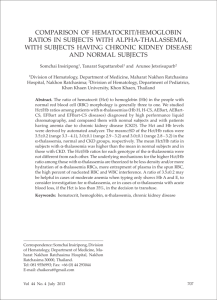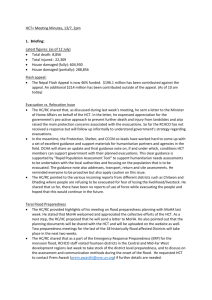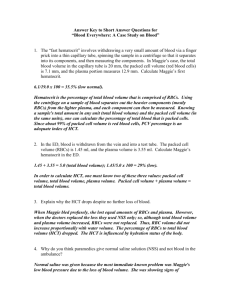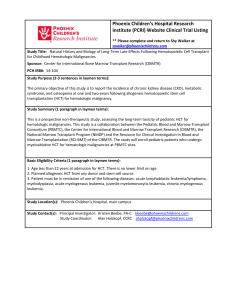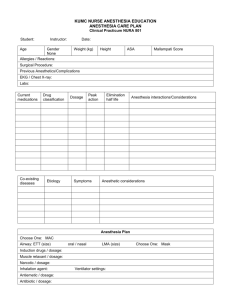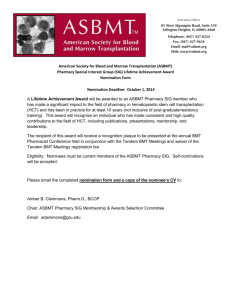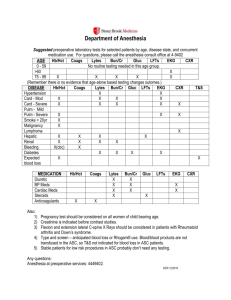comparison of hematocrit/hemoglobin ratios in subjects with alpha
advertisement
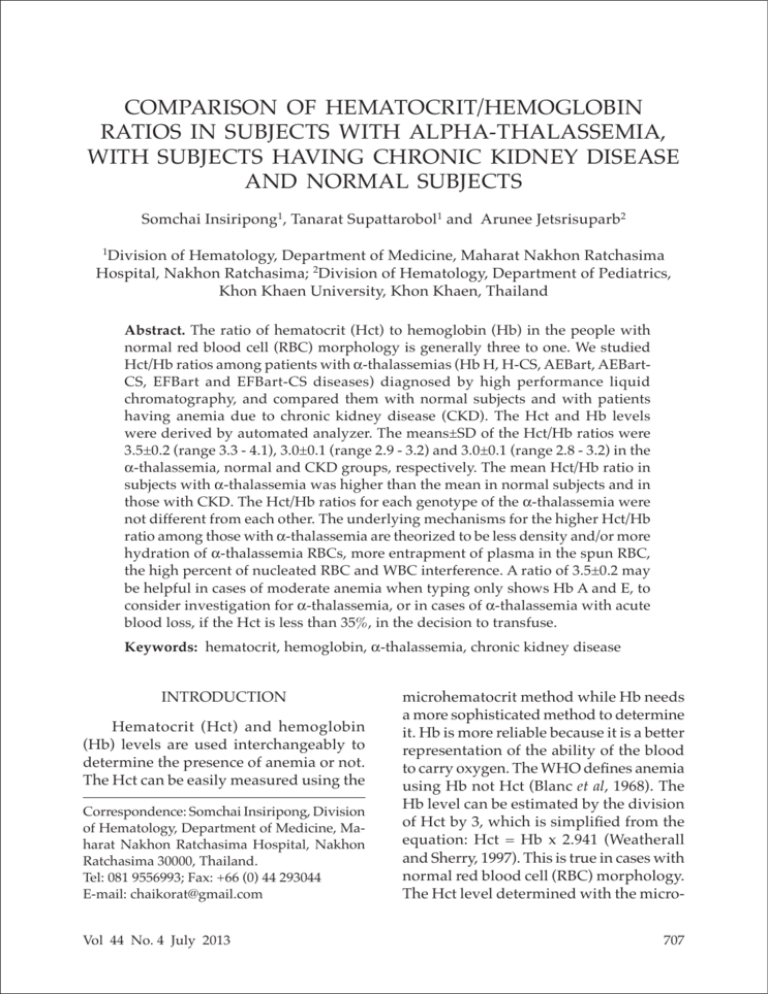
Ratio of Hematocrit to Hemogloin in Alpha-thalassemia Subjects COMPARISON OF HEMATOCRIT/HEMOGLOBIN RATIOS IN SUBJECTS WITH ALPHA-THALASSEMIA, WITH SUBJECTS HAVING CHRONIC KIDNEY DISEASE AND NORMAL SUBJECTS Somchai Insiripong1, Tanarat Supattarobol1 and Arunee Jetsrisuparb2 Division of Hematology, Department of Medicine, Maharat Nakhon Ratchasima Hospital, Nakhon Ratchasima; 2Division of Hematology, Department of Pediatrics, Khon Khaen University, Khon Khaen, Thailand 1 Abstract. The ratio of hematocrit (Hct) to hemoglobin (Hb) in the people with normal red blood cell (RBC) morphology is generally three to one. We studied Hct/Hb ratios among patients with a-thalassemias (Hb H, H-CS, AEBart, AEBartCS, EFBart and EFBart-CS diseases) diagnosed by high performance liquid chromatography, and compared them with normal subjects and with patients having anemia due to chronic kidney disease (CKD). The Hct and Hb levels were derived by automated analyzer. The means±SD of the Hct/Hb ratios were 3.5±0.2 (range 3.3 - 4.1), 3.0±0.1 (range 2.9 - 3.2) and 3.0±0.1 (range 2.8 - 3.2) in the a-thalassemia, normal and CKD groups, respectively. The mean Hct/Hb ratio in subjects with a-thalassemia was higher than the mean in normal subjects and in those with CKD. The Hct/Hb ratios for each genotype of the a-thalassemia were not different from each other. The underlying mechanisms for the higher Hct/Hb ratio among those with a-thalassemia are theorized to be less density and/or more hydration of a-thalassemia RBCs, more entrapment of plasma in the spun RBC, the high percent of nucleated RBC and WBC interference. A ratio of 3.5±0.2 may be helpful in cases of moderate anemia when typing only shows Hb A and E, to consider investigation for a-thalassemia, or in cases of a-thalassemia with acute blood loss, if the Hct is less than 35%, in the decision to transfuse. Keywords: hematocrit, hemoglobin, a-thalassemia, chronic kidney disease INTRODUCTION Hematocrit (Hct) and hemoglobin (Hb) levels are used interchangeably to determine the presence of anemia or not. The Hct can be easily measured using the Correspondence: Somchai Insiripong, Division of Hematology, Department of Medicine, Maharat Nakhon Ratchasima Hospital, Nakhon Ratchasima 30000, Thailand. Tel: 081 9556993; Fax: +66 (0) 44 293044 E-mail: chaikorat@gmail.com Vol 44 No. 4 July 2013 microhematocrit method while Hb needs a more sophisticated method to determine it. Hb is more reliable because it is a better representation of the ability of the blood to carry oxygen. The WHO defines anemia using Hb not Hct (Blanc et al, 1968). The Hb level can be estimated by the division of Hct by 3, which is simplified from the equation: Hct = Hb x 2.941 (Weatherall and Sherry, 1997). This is true in cases with normal red blood cell (RBC) morphology. The Hct level determined with the micro707 Southeast Asian J Trop Med Public Health hematocrit method can be 1.5-3% falsely higher than the actual value because of the small amount of plasma present in the spun, packed RBC. In thalassemia when RBCs have an abnormal size and shape, this percent error may be higher (Linne and Ringsrud, 1999; Bull et al, 2000). In our experience, the value used to estimate Hb from Hct level should be 3.40. level for >3 months, a glomerular filtration rate <10 ml/minute and atrophic kidneys confirmed by the ultrasonography or a computerized tomography scan. CKD patients were chosen as a control group to make sure the Hct/Hb ratio was not influenced by anemia. MATERIALS AND METHODS The mean Hct/Hb ratios for each genotype of a-thalassemia were compared with the Student’s t-test. A p-value<0.01 was considered statistically significant. We studied Hct / Hb ratios among patients with a-thalassemia and compared them with those of normal subjects and those with chronic kidney disease (CKD). The a-thalassemia patients in this study, including those with Hb H, H-CS, AEBart, AEBart-CS, EFBart and EFBart-CS disease, were diagnosed by Hb typing using high performance liquid chromatography. Each subject was investigated with a CBC using an automated hematology analyzer. Other laboratory tests performed were: BUN, creatinine and liver function tests using standard methods. The Hb level was determined by detecting the ability of the complex between Hb and sodium lauryl sulfate to absorb light at 555 nm compared with a blank. The Hct level was determined by the cumulative pulse height detection method. The RBC count was determined using the percent of the height of the counted RBC compared with that of whole blood (Manual for XT2000i, Meditop). We used 2 control groups: 1) normal subjects with a normal CBC; a Hb level >12 g% in females and >13 g% in males; a MCV of 80-100 fl; a MCH of 27-33 pg and normal Hb typing: Hb A2A, A2 2.5-3.5 %; 2) anemic patients with CKD who had normocytic anemia, normal Hb typing, the presence of a high serum creatinine 708 Hct/Hb ratios were determined and then the mean ± standard deviation (SD) for the group were calculated. The means and SDs were compared among the 3 groups with the ANOVA test and a Student’s t-test for each pair. A p-value <0.01 was considered statistically significant. This study was approved by the ethics committee of Maharat Nakhon Ratchasima Hospital and financially supported by the research center of the hospital. The sample size for each group was calculated as follows: N = 2[(Za+Zb)s]2/ [µ1-µ2]2 where Za (desired level of statistic significance) = 2.58 if a = 0.01, Zb (desired power) = 1.65 if b = 0.1, s (standard deviation) = 0.3774, µ1 (mean of Hct/Hb of alpha-thalassemia from our observation) = 3.402, µ2 (mean of Hct/Hb from normal individuals) = 3.034. Za = 2.58, Zb = 1.65, s = 0.3774, µ1 = 3.402, µ2 = 3.034, N = 37.6 ~ 40. RESULTS Fifty-four patients diagnosed as having a-thalassemia were included in the study, 21 were males and 33 were females. Their ages ranged from 16 to 69 years with a mean of 36.2 years. The Hct/Hb ratios in the various groups are shown in Table 1. Vol 44 No. 4 July 2013 Ratio of Hematocrit to Hemogloin in Alpha-thalassemia Subjects Table 1 The Hct/Hb ratios in a-thalassemia, normal and CKD subjects. Ratio of Hct/Hb Minimum Maximum Mean Median SD Number Male:female Age (years) Mean age (years) Hb concentration Mean Hb concentration Hct Mean Hct MCV (Mean ± SD) MCH (Mean ± SD) MCHC (Mean ± SD) RDW (Mean ± SD) a-thalassemia Normal CKD 3.3 4.1 3.5 3.4 0.2 54 21:33 16-69 36.2 3.6-9.5 7.2 12.8-37.6 25.6 62.5±11.4 17.4±1.9 28.4±2.6 26.3±1.8 2.9 3.2 3.0 3.0 0.1 40 14:25 21-76 46.8 12.0-14.8 13.5 36.0-45.6 40.9 87.3±5.6 28.8±2.4 33.1±1.0 15.7±3.3 2.8 3.2 3.0 3.0 0.1 40 12:18 29-79 57.6 3.3-9.5 7.6 10.2-28.1 22.9 89.3±6.1 29.2±1.9 32.3±1.1 13.9±16 CKD, chronic kidney disease; Hct, hematocrit; Hb, hemoglobin; SD, standard deviation; MCV, mean corpuscular volume; MCH, mean corpuscular hemoglobin; MCHC, mean corpuscular hemoglobin concentration; RDW, red blood cell distribution width Table 2 Hct/Hb ratios among study subjects by type of a-thalassemia. Hb H disease Hb H-CS disease Hb AEBart-CS disease Hb EFBart disease Hb AEBart’s disease Hb EFBart-CS disease Total Number (%) Hct/Hb ratio p-value 9 (16) 15 (27.8) 11 (20.4) 10 (18.5) 5 (9.3) 4 (7.4) 54 (100) 3.5 3.6 3.5 3.4 3.5 3.5 3.5 0.56 0.27 0.42 0.24 0.83 0.79 Using the ANOVA test, there were significant differences in the mean Hct/Hb ratios between those with a-thalassemia and normal and CKD patients (p= 0.000). Using the Student’s t-test to verify the different pairs, the mean Hct/Hb ratio Vol 44 No. 4 July 2013 among the a-thalassemia patients was significantly different from the normal group (3.0) (p<0.0001) and also of the CKD group (3.0) (p<0.0001). No significant differences (p=0.904) was seen in Hct/Hb ratios between normal 709 Southeast Asian J Trop Med Public Health subjects and those with CKD. The type and number of patients with each genotype of a-thalassemia with their Hct/Hb ratios are shown in Table 2. The mean Hct/Hb ratio among patients with a-thalassemia was 3.5 which was not different from 3.5, 3.6, 3.5, 3.5, 3.4 and 3.5 of Hb H, H-CS, AEBart, AEBartCS, EFBart and EFBart-CS disease, respectively. Among the different genotypes of a-thalassemia, the mean Hct/Hb ratio of each genotype was not different from each other. DISCUSSION The Hct/Hb ratio range among normal subjects (2.9-3.2) and among those with CKD (2.8-3.2) did not overlap with the range among subjects with a-thalassemia (3.3-4.1). The a-thalassemic RBCs are on average less dense than normal while some b-thalassemic RBCs have a broader distribution in density, with some RBCs being more dense and some being less dense than normal (Schrier et al, 1989), implying cellular dehydration in b-thalassemia but not in a-thalassemia. The less dense RBCs found in a-thalassemia may be the underlying cause of a falsely high Hct due to greater hydration of RBCs. A study of the pathobiologic features of RBCs in a- and b- thalassemia (Bunyaratvej et al, 1994) supports this theory of cell density because RBCs in a-thalassemia have a lower Hb concentration and higher cell hydration, whereas RBCs in b-thalassemia have a lower Hb concentration and a lower cell hydration. The plasma present in spun packed RBCs in which the RBCs have abnormal shapes and sizes may result in a Hct that is 1.5-3% falsely higher than the actual Hct (Linne and Ringsrud, 1999; Bull et al, 2000). 710 In cases where the percent of reticulocytes or white blood cell count is high, which can be found in hemolytic disease, Hct determination using an analyzer can result in falsely elevated values because the higher volumes of these cells can interfere with the RBC count and the calculation of Hct (Thomas, 1998). In our study of Hct/Hb ratios in the different genotypes of a-thalassemia, none of the ratios were significantly different from each other. In a study of 15 different genotypes of Hb H disease among 75 Greek patients, the mean Hct/Hb ratio was 3.6 (Kanavakis et al, 2000), similar to our findings. A study from Saudi Arabia (Qadri and Islam, 2000) found a mean Hct/Hb ratio of 3.4 among patients with Hb H disease, a study from Hong Kong (Todd, 1984) found a mean Hct/Hb ratio of 3.8 among patients with Hb H disease. The Hct/Hb ratios in subjects with Hb H-CS with Hb J-Bangkok, Hb H- Hb Paksé and a-thalassemia-1 trait were 3.6 (Fucharoen et al, 2001), 4.1 (Viprakasit et al, 2002) and 3.3 (Pornpatkul et al, 1969), respectively. The mean Hct/Hb ratio among the patients with various a-thalassemias was 3.5. This ratio may be helpful in suggesting a diagnosis of a-thalassemia prior Hb type testing. In a case suspicious for thalassemia but the Hb typing just shows only Hb E trait without Hb Bart, if the Hct/Hb ratio is around 3.5, it is reasonable to investigate for a-thalassemia. In cases of a-thalassemia with acute blood loss, if the Hct is <35%, a transfusion is recommended because the Hct after being corrected by 3.5 will be <30%. Further studied using this cut-off value are needed to determine its predicability, sensitivity, specificity and positive Vol 44 No. 4 July 2013 Ratio of Hematocrit to Hemogloin in Alpha-thalassemia Subjects predictive value as a simple screening test. REFERENCES Blanc B, Finch CA, Hallberg L, et al. Nutritional anaemias. Report of a WHO Scientific Group. WHO Tech Rep Ser 1968; 405: 1-40. Bull BS, Koepke JA, Simson E, van Assendelft OW. Procedure for determining packed cell volume by the microhematocrit method. 3rd ed. Wayne, Pennsylvania: National Committee for Clinical Laboratory Standards, 2000 (18): Document H7-A3; 4. Bunyaratvej A, Fucharoen S, Greenbaum A, Mohandas N. Hydration of red cells in alpha and beta thalassemias differs. A useful approach to distinguish between these red cell phenotypes. Am J Clin Pathol 1994; 102: 217-22. Fucharoen S, Ayukarn K, Sanchaisuriya K, Fucharoen G. Atypical hemoglobin H disease in a Thai patient resulting from a combination of a-thalassemia 1 and hemoglobin Constant Spring with hemoglobin J Bangkok heterozygosity. Eur J Haematol 2001: 66: 312-6. Kanavakis E, Papassotiriou I, Karagiorga M, et al. Phenotypic and molecular diversity of haemoglobin H disease: a Greek experience. Br J Haematol 2000; 111: 915-23. Vol 44 No. 4 July 2013 Linne JJ, Ringsrud KM. Clinical laboratory science, the basics and routine techniques. 4th ed. St. Louis: Mosby, 1999: 279-95. Pornpatkul M, Wasi P, Na-Nakorn S. Hematologic parameters in obligatory alpha-thalassemia. J Med Assoc Thai 1969; 52: 801- 11. Qadri MI, Islam SA. Hemoglobin H disease in the eastern region of Saudi Arabia. Saudi Med J 2000; 21: 666-71. Schrier SL, Rachmilewitz E, Mohandas N. Cellular and membrane properties of alpha and beta thalassemic erythrocytes are different: implication for differences in clinical manifestations. Blood 1989; 74: 2194-202. Thomas L. Hematocrit (HCT). In: Thomas L, ed. Clinical laboratory diagnostics, use and assessment of clinical laboratory results. Frankfurt/Main: TH-Books-Verl.-Ges, 1998: 479-82. Todd D. Thalassaemia. Pathology 1984; 16: 5-15. Viprakasit V, Tanphaichitr VS, Pung-amritt P, et al. Clinical phenotypes and molecular characterization of Hb H-Paksé disease. Haematologica 2002; 87: 117-25. Weatherall MS, Sherry KM. An evaluation of the Spuncrit™ infra-red analyzer for measurement of haematocrit. Clin Lab Haem 1997; 19: 183-6. 711
